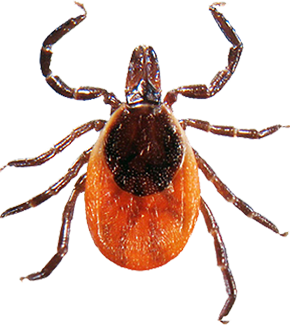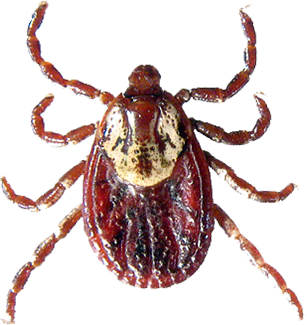Tick-borne Disease and Ticks
As of summer 2020, Northwestern Health Unit (NWHU) no longer accepts ticks for lab testing. Lyme Disease is present in our catchment area and you should consider it a possibility if a black-legged tick was attached for more than 24 hours, and from Kenora, Rainy River, Fort Frances, or the areas that surround these municipalities. You can identify by visiting etick.ca. If you have trouble using this website, call us at 807-468-3147 for assistance.
Tick-borne diseases occur when an infected tick bites and infects a person. In northwestern Ontario, there are several species of ticks. The only species responsible for spreading tick-borne diseases to humans in our area is Ixodes scapularis (A.K.A the deer tick or black-legged tick). Other tick species, such as the more common wood tick, are not known to pass illnesses to humans.
NWHU tracks medically confirmed tick-borne diseases like Lyme disease and Anaplasmosis. We also perform active tick surveillance to know where ticks are in our region and if they are carrying tick-borne diseases. In 2018, the Kenora region was added as an estimated risk area for Lyme disease by Public Health Ontario. Rainy River and the surrounding area were identified as an estimated risk area for Lyme disease in 2013. In 2020, Fort Frances and the surrounding area were added as an estimated risk area for Lyme disease.
We offer tick identification cards that show the difference between wood (dog) ticks and the black-legged (deer) tick, which can carry tick-borne disease. You can also get a ‘tick kit’ that includes information and a tool to help remove ticks that are stuck in the skin.
Preventing ticks and tick bites
To help prevent tick bites, do the following:
- Wear light coloured clothing so ticks are easier to spot.
- Keep covered with long pants and a long-sleeved shirt.
- Wear closed footwear, socks, and tuck your pants into your socks.
- Use a tick repellant that has “DEET” (follow the manufacturer’s directions).
- Put a tick and flea collar on your pets, and check them for ticks periodically.
- Search your body well for ticks after being in grass or bushy areas. Pay special attention to groin, scalp, and armpits. Use a mirror to check your back.
To help discourage ticks from being on your property, do the following:
- Mow the lawn regularly.
- Remove leaf litter, brush and weeds.
- Keep tree branches and shrubs trimmed to let in more sunlight.
- Move children’s swing sets and sandboxes away from the wooded or bushy edges of a play area. Consider placing swing sets and sandboxes on a woodchip or mulch foundation.
- Ticks often attach themselves to rodents, deer and birds. Keep rodents away by sealing stone walls and small openings around the yard. Use plants that do not attract deer or consider fencing to keep deer out of the yard. If you have a bird feeder keep it away from the house.
For more information on ticks in our area, call 1-800-830-5978 or email talkpublichealth@nwhu.on.ca.
Identifying ticks
Black-legged (deer) tick

Colour
Dark brown to black, females have an orange/red back
Size
Adults are 3-5mm long
Lyme
Must be attached to a human for a minimum of 24-36 hours before Lyme disease can be transmitted
Dog (wood) tick

Colour
Red-brown with white markings on back; elongated body
Size
Adults are 4-6mm long
Lyme
Not known to transmit Lyme disease
Removing ticks safely
If you think you have found a black-legged tick on yourself, a family member, or a friend and would like to identify it, visit etick.ca. If you have trouble accessing this service, please contact us for help.
How to remove a tick
Fast removal of ticks will help to prevent infection.
Follow these tips to remove ticks:
- Grasp the tick with tweezers as close to the skin as possible.
- Pull it straight out, gently but firmly.
- Don’t squeeze the tick.
- Don’t put anything on the tick or try to burn it off.
- Wash the area with soap and water once removed.
If the black-legged tick was attached for more than 24 hours, and from Kenora, Rainy River, or the areas surrounding these municipalities, consider visiting a health care provider within 72 hours of removing the tick.
Tick-borne diseases
The following are tick-borne diseases that you can find in our area.
Lyme disease
Lyme disease is an infection caused by the bacteria Borrelia burgdorferi. These bacteria are spread by the bite of a black-legged (deer) tick. The black-legged tick is found throughout Ontario, including the Northwestern Health Unit region.
They are very small and hard to see. Not all black-legged (deer) ticks carry the bacterium that causes Lyme disease. Ticks must be attached for at least 24 hours for transmission of the bacterium to occur and is most likely if they have been attached for at least two days of feeding.
Symptoms of Lyme disease usually begin within three days to one month of being bit. The symptoms include fever, headache, muscle and joint pain, fatigue, and a skin rash that looks like a red bull’s eye.
Risk of Lyme disease
The risk of being bitten by a black-legged tick largely depends on the activities of the person. A person is more likely to be bitten by a black-legged tick if they are:
- Walking through a wooded or bushy area.
- Not wearing protective clothing.
- Not using an appropriate insect repellant.
The risk of being bitten may be higher in Kenora, Rainy River, or the areas surrounding these municipalities where black-legged ticks have been repeatedly collected. Some of these ticks tested positive for carrying the bacteria that causes Lyme disease. If bitten, you can prevent the transmission of disease by removing the tick within 24 hours.
Diagnosis and treatment of Lyme disease
If a black-legged tick was attached for more than 24 hours, and from Kenora, Rainy River, or the areas surrounding these municipalities, consider visiting a health care provider within 72 hours of removing the tick.
Anaplasmosis
Anaplasmosis is an infection caused by the bacteria Anaplasma phagocytophilum. Humans can become infected with this bacterium when they are bitten by an infected black-legged tick, also known as a deer tick. This type of tick is found throughout Ontario, including the Northwestern Health Unit region. Blacklegged ticks are very small and hard to see. Not all black-legged (deer) ticks carry the bacterium that causes Anaplasmosis.
Symptoms of Anaplasmosis usually begin within five days to three weeks of being bit. The symptoms include fever, headache, chills, muscle and joint pain, fatigue, and nausea. Less common symptoms include abdominal pain, vomiting, cough, and confusion. A rash is rarely noticed. Anaplasmosis is most often a mild and self-limiting illness. More serious infections and complications may occur in people who have weak immune systems or in older adults.
Risk of Anaplasmosis
The risk of getting Anaplasmosis depends on the risk of being bitten by a black-legged tick that can carry the bacteria for Anaplasmosis.
The risk of being bitten by any black-legged tick mainly depends on the activities of the person. A person is more likely to be bitten by a black-legged tick if walking through a wooded or bushy area and if not wearing protective clothing or using an appropriate insect repellant.
The fall of 2017 was the first year that a small number of ticks in Kenora and the surrounding area tested positive for the bacteria that causes Anaplasmosis. It is uncertain whether ticks will continue to test positive. Further tick surveillance is required to determine if this is an ongoing risk for this area. If bitten, the disease can be prevented by removing the tick within 12 to 24 hours.
Diagnosis and treatment of Anaplasmosis
Anaplasmosis is diagnosed by clinical signs and symptoms and blood testing. Early antibiotic treatment is recommended. If you have symptoms of Anaplasmosis, see your doctor.
Tick-borne disease and tick surveillance
Public health’s role in Lyme disease is to measure and evaluate risk. The health unit conducts active surveillance, tick dragging, in the spring and fall to determine if there are deer ticks, black-legged ticks, in our area.
Active tick surveillance (tick dragging)
We did not conduct any active surveillance in the spring of 2020 because of the COVID-19 pandemic.
We carried out active surveillance in 2019 in the Rainy River District near Fort Frances. We captured and tested a total of 20 deer ticks, 9 of which (45%) tested positive for Lyme Disease.
Active tick surveillance in NWHU’s catchment area, 2019
| Location | Negative | Positive | Total | Percent positivity |
|---|---|---|---|---|
| East of Fort Frances | 4 | 9 | 14 | 69.2% |
| Alberton area | 1 | 0 | 1 | 0.0% |
| Morley area | 1 | 0 | 1 | 0.0% |
| Emo area | 0 | 0 | 0 | N/A |
| Windy Point area | 4 | 0 | 4 | 0.0% |
| Stratton area | 1 | 0 | 1 | 0.0% |
| Total | 11 | 9 | 20 | 45.0% |
Active tick surveillance in NWHU’s catchment area, 2018
| Location | Negative | Positive | Total | Percent positivity |
|---|---|---|---|---|
| West of Fort Frances | 10 | 2 | 12 | 16.7% |
| Rainy River area | 1 | 0 | 1 | 0.0% |
| McKenzie Portage area, Kenora | 21 | 16 | 37 | 43.2% |
| Lake of the Woods (township) | 16 | 13 | 29 | N/A |
| Total | 48 | 31 | 79 | 39.2% |
Lyme disease in humans – northwestern Ontario
There were 4 confirmed cases of Lyme Disease in humans in the NWHU area in 2019. This is a typical number of cases in recent years, with the average of the previous 5 years being 4.8 cases per year or 5.7 per 100,000 people per year. The provincial rate over the past 5 years is 4.7 cases per 100,000 people per year.
Public Health Ontario provides a 2020 map of areas that may pose a risk of Lyme Disease. You can access it by visiting Ontario Lyme Disease Map 2020: Estimated Risk Areas.